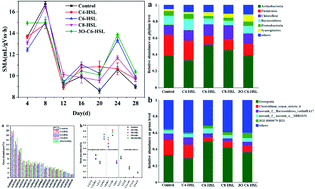Effects of different N-acyl-serine lactone signaling molecules on the performance of anaerobic granular sludge
Abstract
Exogenous addition of acyl-homoserine lactone (AHL) signaling molecules can improve or inhibit the methane production performance of anaerobic granular sludge (AnGS) by quorum sensing (QS). To explore the specific effect of AHLs on AnGS, 2 μM of signal molecules were added to the reactor and we analyzed their effects on AnGS biodiversity, extracellular polymeric substance (EPS), specific methanogenic activity (SMA) and chemical oxygen demand (COD) removal rate of AnGS. The results indicated that the four types of AHLs improve the COD removal rate, SMA and organic composition of AnGS. The addition of N-(β-ketocaproyl)-DL-homoserine lactone (3O-C6-HSL) yielded the greatest increase in methanogenic activity, reaching a maximum of 30.83%. The four types of AHLs stimulate the secretion of EPS in AnGS by group sensing regulation. The addition of N-hexanoyl-L-homoserine lactone (C6-HSL), N-octanoyl-DL-lactone (C8-HSL) and 3O-C6-HSL induced the enrichment of Actinobacteria. Thus, the process of hydrolysis and acidification of AnGS is accelerated. The addition of N-butyryl-DL-homoserine lactone (C4-HSL), C6-HSL and 3O-C6-HSL promote the potential methanogenic metabolic pathway of AnGS. The addition of all AHLs directly or indirectly enhanced the methane metabolism pathway of sludge and improved the specific methane generation activity of AnGS. These results are expected to provide preliminary research data for enhancing the methane production efficiency of reactors and enriching the biological activity of AnGS.



 Please wait while we load your content...
Please wait while we load your content...